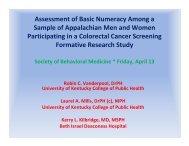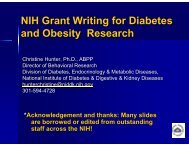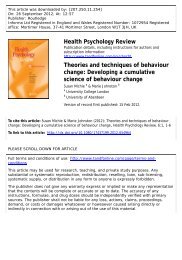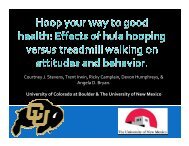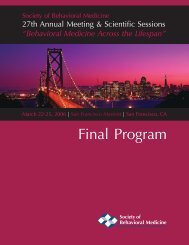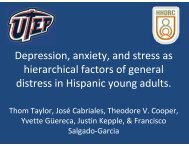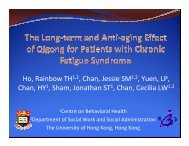Fibromyalgia Syndrome: Perils of the Patient Uniformity Myth
Fibromyalgia Syndrome: Perils of the Patient Uniformity Myth
Fibromyalgia Syndrome: Perils of the Patient Uniformity Myth
- No tags were found...
Create successful ePaper yourself
Turn your PDF publications into a flip-book with our unique Google optimized e-Paper software.
<strong>Fibromyalgia</strong> <strong>Syndrome</strong>: <strong>Perils</strong> <strong>of</strong> <strong>the</strong> <strong>Patient</strong><strong>Uniformity</strong> <strong>Myth</strong>Dennis C. Turk, Ph.D.University <strong>of</strong> Washington School <strong>of</strong> MedicineDisclosure: Grant Support and /or consulting with Abbott, Eli Lily,Endo, Feering, GTx, Ortho-McNeil Janssen, Pfizer, PriCara, PhilipsRespironics, SK Life Science, <strong>the</strong> United States Food and DrugAdministration and National Institutes <strong>of</strong> Health
Epidemiology <strong>of</strong> FMS 5 million Americans over age 18 .64 – 10.5% <strong>of</strong> community populations7:1 females/males treatment seekers3:1 females/males community samples 12 – 20% <strong>of</strong> new patients in outpatientrheumatology clinics1 Lawrence et al. Arthritis & Rheumatism 2008;58:26-35..
FMS: Health Care Consumption Studied over 33,000 people diagnosed with FMS andcompared to age and sex matched people seekingmedical care over 12 months 1 Mean/median total health care costs over 3 timeshigher in FMS patients compared to o<strong>the</strong>r group($9,573/$4,247) vs. ($3,291/$822) 1 20% vs 9% had at least 1 ED visit 1 Indirect costs <strong>of</strong> FMS estimated to be $8,670 annually 2 Total annual cost <strong>of</strong> FMS $12,917/18,243 2 If average age <strong>of</strong> patients with FMS = 45 1 at lifeexpectancy = 76 years, <strong>the</strong>n <strong>the</strong> life time cost <strong>of</strong> FMS(direct and indirect, not correcting for inflation) =$413,344/$583,7761 Berger et al. Int J Clin Pract 2007;61:1498-508; 2 Penrod et al. J Rheumatol 2004;31:1391-9
Dimensions <strong>of</strong> FMS Allodynia and Hyperalgesia Multiple co-Morbid symptoms Deconditioning Functional disability Psychosocial problems Health care costs
Possible Pathophysiologic Mechanisms- Central NOT Peripheral Abnormality in neuroendocrine system - eg,Somatomedin C, Prolactin, Substance P Defect in brain chemistry: eg, Serotonin, Glutamate Impairment or dysfunction in information processing Disturbance in <strong>the</strong> hypothalamic-pituitary-adrenal(HPA) axis Abnormality in Diffuse Noxious Inhibitory Control(DNIC) Psychologic originCombination <strong>of</strong> more than one <strong>of</strong> above
There are two kinds<strong>of</strong> people in <strong>the</strong> world…those who think <strong>the</strong>reare two kinds <strong>of</strong>people and thosewho don’t.The first group can belabeled splitters, <strong>the</strong>latter lumpers.
<strong>Perils</strong> <strong>of</strong> <strong>the</strong> <strong>Patient</strong> <strong>Uniformity</strong> <strong>Myth</strong>Ignoring patien<strong>the</strong>terogeneityTreating allpatients <strong>the</strong> sameInconsistentresearch resultsLittle understanding <strong>of</strong> whattreatment works for whom
Subgrouping <strong>Patient</strong>s Biomedical Symptoms (number, pattern) Mechanisms Etiological Psychological Response to Treatment Demographic
ACR Tender Point LocationsOcciput: at <strong>the</strong> suboccipital muscle insertions.Low cervical: at <strong>the</strong> anterior aspects <strong>of</strong> <strong>the</strong>intertransverse spaces at C5-C7.Trapezius: at <strong>the</strong> midpoint <strong>of</strong> <strong>the</strong> upperboarder.Supraspinatus: at origins, above <strong>the</strong> scapulaspine near <strong>the</strong> medial boarder.Second rib: at <strong>the</strong> second costochondraljunctions, just lateral to <strong>the</strong> junctions on uppersurfaces.Lateral epicondyle: at 2cm distal to <strong>the</strong>epicondyles.Gulteal: in upper outer quadrants <strong>of</strong> buttocksinanterior fold <strong>of</strong> muscle.Greater trochanter: posterior to <strong>the</strong>trochanteric prominence.Knee: at <strong>the</strong> medial fat proximal to <strong>the</strong> jointline.* = Control points***
9876543n=184, 26.7%n=292, 42.3%n=214, 31.0%Cluster Analysis <strong>of</strong>Tender PointsB. Cluster groups for Sample 2 (N=743)210NSfacmean GTfacmean UEfacmean COfacmeanCluster groups for Sample 2(N=743)Cluster groups for Sample 1(N=690)98NS, Neck/ShoulderGR, Gluteal/TrochantericUE, Upper extremityCO, Control765432n=131, 17.6%n=307, 41.3%n=305, 41.1%Wilson H, et al. J Rheumatol2009;36:2795-280110NSfacmean GTfacmean UEfacmean COfacmean
Who Treats <strong>Fibromyalgia</strong> <strong>Patient</strong>s?Orthopedists 1,070,000 hits 1Psychologists 831,000Physical <strong>the</strong>rapists 779,000Chiropractors 747,000What not primary care?Homeopaths 462,000Nutritionists 390,000Rheumatologists 243,000Physiatrists 70,000Pain clinics 43,600Lawyers 838,000 21Google hits 9/9/08 using “fibromyalgia AND type <strong>of</strong> health practitioner” as search terms;2Google hits, “Lawyer <strong>Fibromyalgia</strong>”
Co-occurring Symptoms (n = 573)Fatigue 97%Muscle tenderness 95%Sleep disturbance 90%Widespread pain 88%Joint pain/tenderness 85%Morning stiffness 80%Pares<strong>the</strong>sia 76%Nervous/Irritable 74%Depression 70%Tension Headaches 66%Feeling cold 64%Night sweats 54%Changed bowel habits 54%Dry/itchy eyes 53%Jaw pain 53%Migraine Headaches 53%
Co-occurring Symptoms (n = 573)Chest pain/Tightness 48%Feeling swollen joints 47%Abdominal cramps 46%Stomach pain 45%Legs jerk at night 45%Teeth grinding/night 45%Breathing prob w/ex 40%Skin rashes 40%Jaw sounds/click,pop 38%Swollen ankles 37%Menstrual problems 37%Crawling sensation/leg 34%Sore throat/frequent 32%Constipation 32%Freq urination/night 31%Hands turn white/cold 27%
Co-occurring Symptoms (n = 536)Unexplained fever 25%Persistent diarrhea 25%Lump neck/armpit/groin 24%Difficulty urinating 22%Excessive bleeding 10%Blood in stools 10%Dark black stools 10%Coughing up blood 4%Prob breathing/reclining 19%Wt loss 10 lbs or more 16%Painful urination 16%Eyes red/persistent 15%
Cluster Analysis <strong>of</strong> FMS Symptoms4 Cluster Solution Sample 1Regression Factor Score21.510.50-0.5Core Physical Atypical Physical PsychologicalHigh Severity (n=202)Mod.Phys./High Psyc. (n=304)Mod. Phys./Low Psyc (n=274)Low Severity (n=291)Cluster Sample 1 Sample 21 19% 21%2 28% 25%3 26% 26%4 27% 27%-1-1.5FactorReplication, N = 1,111Sample 1, N = 1,0714 Cluster Solution Sample 2Core Sx Psych/CognPain AnxietyMuscle spasm AngerStiffness DepressionAtypical Sx ForgetfulnessRashes ConcentrationAbd. pain prob.Bladder prob.Regression Factor Score21.510.50-0.5-1-1.5Core Physical Atypical Physical PsychologicalHigh Severity (n=237)Mod.Phys/High Psyc 3(n=282)Mod.Phys/Low Psyc 2 (n=291)Low Severity (n=301)FactorWilson H, et al. Arthritis Care Res, 2009;61:527-534
Attributed Cause <strong>of</strong> Symptoms(N = 555)Accident at work = 5.9%Accident at home = 1.7%Automobile accident = 13.8%Following surgery = 5.4%Following an illness = 9.6%No identifiable cause = 39.5%O<strong>the</strong>r = 21.0%Precipitatingevent = 36.4%
Traumatic-Onset vs. Idiopathic-OnsetFM: Employment & Disability 1Idiopathic TraumaLost Employment Due to FM 12% 70%Reduced Physical Activity 15% 45%Disability Compensation 1% 34%1Adapted from Greenfield et al. Arthritis Rheum 1992;35:678-81
Symptom Reporting Traumatic-Onset FM vs.Idiopathic FM 1SymptomsStiffnessIdiopathicTraumaticAM FatigueRib Cage PainMuscle Fatigue0 20 40 60 80 1001Adapted from Waylonis et al. Am J Phys Med Rehabil 1994;73:403–12%
Background InformationTraumatic (n=46)Idiopathic (n=46)Age 50.46 (11.97) 48.46 (10.08)Sex (female) 94% 94%HS. Education 81% 93%Married 57% 66%Duration (mos.) 86.75 (98.23) 98.52 (92.28)Turk DC, et al. J Rheumatol 1996;23:1255-62
Biomedical and Psychosocial Findings byOnset in FMS <strong>Patient</strong>sMean MEDICS T-Scores6055504540NSBiomedicalFindingsTraumaticMean Scores543210IdiopathicPainSeverityP
Observed Physical Function and PerceivedDisability by Onset in FMS <strong>Patient</strong>sTraumaticIdiopathicMean ROM56524844403632282420NSMean NDI4947454341393735P
Influence <strong>of</strong> Onset onFMS Treatments9080TraumaticIdiopathic70Prescribed, %60504030All P
Multidimensional Pain InventoryPart I Pain Severity InterferencePart II Negative Resp. Solicitious Resp.Part III Houshold Chores Outdoor Work Life Control Distracting Resp. Affective Distress Support Activities Away from Home Social ActivitiesKerns RD, et al. Pain 198523:345-56
Unique Characteristics <strong>of</strong> Subgroups <strong>of</strong> ChronicPain <strong>Patient</strong>s Based on Adaptation - MPIDysfunctionalHi painHi emot distressInterpersonallyLo sense controlDistressedLo activityLo supportLo solicitous respLo distract respHi negative respTurk DC, Rudy TE. Behav Ther Res. 1987;25:237-49Adaptive CopersLo emot distressHi sense controlHi activity
Observed Physical Functioningby MPI SubgroupsDYS ID AC7LumbarFlexion40Fingertipsto Floor100StraightLeg Raise50CervicalROM384568036405346035323044030253282020None statistically significantTurk DC, et al. Pain 1996;68:423-30
MPI Pr<strong>of</strong>ile DistributionsDYSIDACCLBP 1 HA 1 TMD 1 SLE 3 MetCa 4 Local Ca 462% 46% 44% 14% 64% 31%18% 22% 26% 28% 6% 35%20% 32% 30% 46% 31% 34%FMS 226%39%35%1 Turk & Rudy. Pain, 1990;43:27-36; 2 Turk et al. J Rheumatol, 1996;23:1255-62; 3 Greco et al.Pain Medicine, 2003;4:39-50; 4 Turk et al. Pain, 1998;74:247-56
MPI Pr<strong>of</strong>ile DistributionsTraumatic vs Idiopathic FMSMPI Pr<strong>of</strong>ilesAdaptiveCoperInterpersonallyDistressedIdiopathicTraumaticDysfunctional0 10 20 30 40 50Frequency (%)TurkDC, et al. J Rheumatol 1996;23:1255-62
AntidepressantsMAO InhibitorsMoclobemidePirlindoleTricyclicsAmitriptylineCyclobenzaprineClomipramineDothiepimDoxepinTetracyclicMaprotilineMirtazapineSSRIsCitalopramFluoxetineSertalineParoxetineSNRIsDuloxetineMilnacipranVenlafaxineTreatments for FMS: PharmacologicalOpioidsMorphineTramadol + APAPSedative/HypnoticsSodium OxybateZolpicloneZolpidemAnticonvulsantsPregbalinN = 57PramipexoleRopinirole5-HT3 AntagonistsOndanseronTropisetronNMDA AntagonistsDextromethorphanKetamineSupplementsSAM-eGinko BilobaNSAIDSIbuprophenNaproxenMuscle relaxantsCyclobenzaprineTizanidineCarisoprodol +Parcetamol + CafO<strong>the</strong>rPrednisoneTopical CapsaicinMalic Acid +Magnesium HydroxAntidiencephalonImmune SerumMexillitineMyanserineChlormezanoneDelta-9-THCAlprazolamBomazepamCoenzyme Q10Growth HormoneGuanethidineInterferon alpha5-HydroxytrptophanMoclobemideLignocainePindololTenoxicamTiapr<strong>of</strong>enic acidMelatoninStaph. ToxoidTropisetronRhus toxicodendronGamma-HydroxybuturateStaph toxoidCalcitoninNabilone
Conclusion About Pharmacologic Treatments“Although various pharmacological treatmentshave been studied and espoused for treatingfibromyalgia, no single drug or group <strong>of</strong> drugshas proven to be particularly useful in treatingfibromyalgia patients.”Abeles et al. Am J Med 2008;121:555-61
Treatments for FMS: Non-PharmacologicalAcupunctureAerobic exerciseAloe veraAnthocyanidinsAutogenic trainingBalneo<strong>the</strong>rapyBi<strong>of</strong>eedbackBioresonance<strong>the</strong>rapyChorellaCBTCryo<strong>the</strong>rapy (wholebody)Delta wave sleepinterruptionEducationEEG-drivenstimulationElectroacupunctureTENSECTManip + UltrasoundFeldenkraisFlexibility exerciseGuided imageryHomeopathic vellumHot PacksHyperbaric OxygenHydrogalvanic <strong>the</strong>rapyHypno<strong>the</strong>rapyLaserN<strong>the</strong>rapy= 55Light <strong>the</strong>rapyMagnetized mattressMarital counselingMeditationMuscle vibrationNeck supportOperant conditioningPsychomotor <strong>the</strong>rapyQigong +Mindful MeditationRelaxationStress managementPeripheral NeurostimStretching exerciseSulphur mud bathsTender pt injectionsWritten emotionalexpressionConnective tissuemanip. + ultarsoundAmitriptyline +Stanger bathMassagePool exercise +educationAquatic exercise(deep water running)Warm water exerciseTranscranial DirectCurrent StimulationElectromagneticShielding FabricValerian bathDance/Movement Ther024 essential oilOmega-3 fatty acid
Predictors <strong>of</strong> Clinically Meaningful Response at 12 mo.Follow-up – Physical Functioning (PF) & Pain Intensity (PI)High Phys ImpairPainHigh Pain BehavHigh Solict SpouseLow Phys FunctMore MD VisitsHigh CatasHigh Affect DistLow Solicit SpouseLow Pain BehavLow CopingHigh Neg SupportThieme K, et al. Arthritis Care Res, 2007;57:830-6Treatments (15 weekly grp sessions)Operant CBT Attention Control(n = 43) (n= 42) (n = 40)% Respond PF/PI 58.1%/53.5% 38.1%/45.2% 5.0%/7.5%XXXXXXXXXXXX
FMS Treatment ProgramOutpatient, 6, 3 hour sessions, once/wkMedical – educational, reassurancePhysical – aerobics and stretching exercisesOccupational – pacing, body mechanicsPsychological – pain and stress managementTurk DC, et al. in preparation
Interdisciplinary Rehabilitation Outcomes[N = 322]Significant reduction in pain (F=31.68;P
Change in <strong>the</strong> MPI Pr<strong>of</strong>ilesPosttreatmentPosttreatment %10090807060504030201006215233854880137DYS ID ACMPI Pr<strong>of</strong>ilesACIDDYSTurk DC, et al. Arthritis Care Res 1998;11:397-404
Hypo<strong>the</strong>tical Two Dimensional Model <strong>of</strong> FMSPsychosocial Factors1FMS2Biomedical Factors
Customizing Treatment <strong>of</strong> FMSBiomedicalTargetsXPsychosocialTargetsBiomedical TreatmentMedicationYes NoPsychosocial TreatmentOC CBTSCYes No Yes No Yes No
Arguments That Support Splitting& Treatment in Primacy CarePathophysiologic mechanisms – nothing definitive<strong>the</strong>re may be more than one causeDifferent diagnostic and symptom patternsDifferent patterns <strong>of</strong> coping and adaptationMany diverse treatments effective for at least somepatientsNo treatment effective for all patientsSince no cure, appropriate treatment in primary care
“It will never happen.”But that’s ano<strong>the</strong>r lecture!



